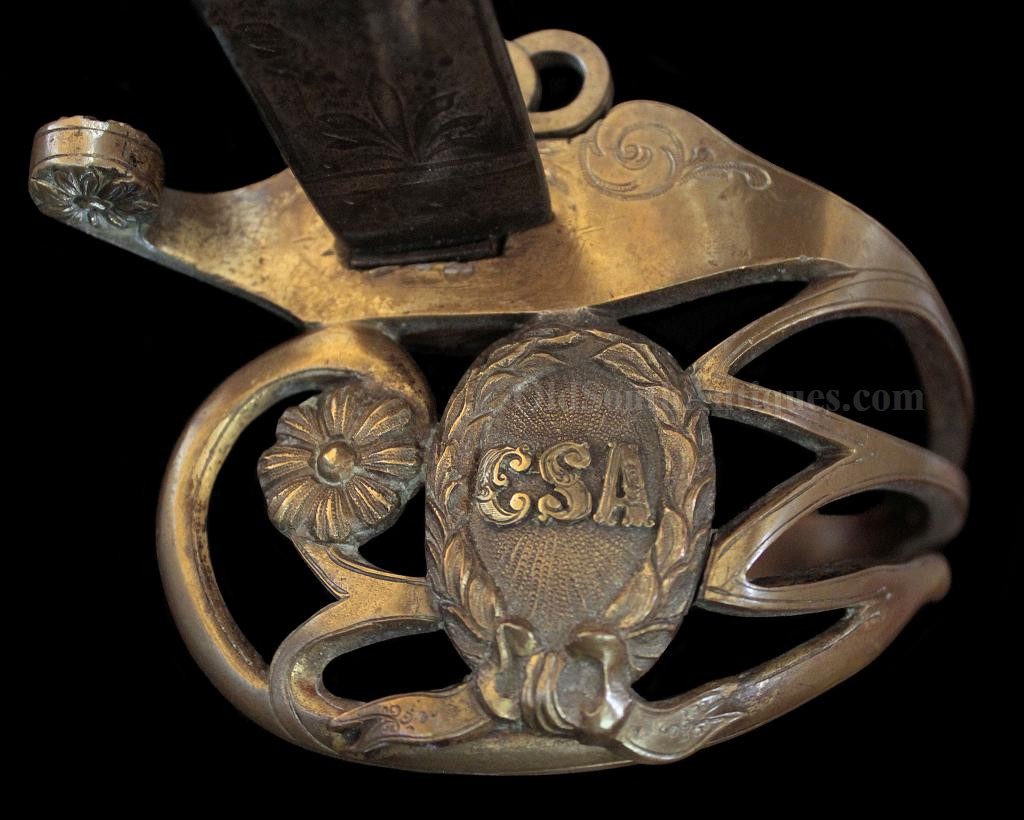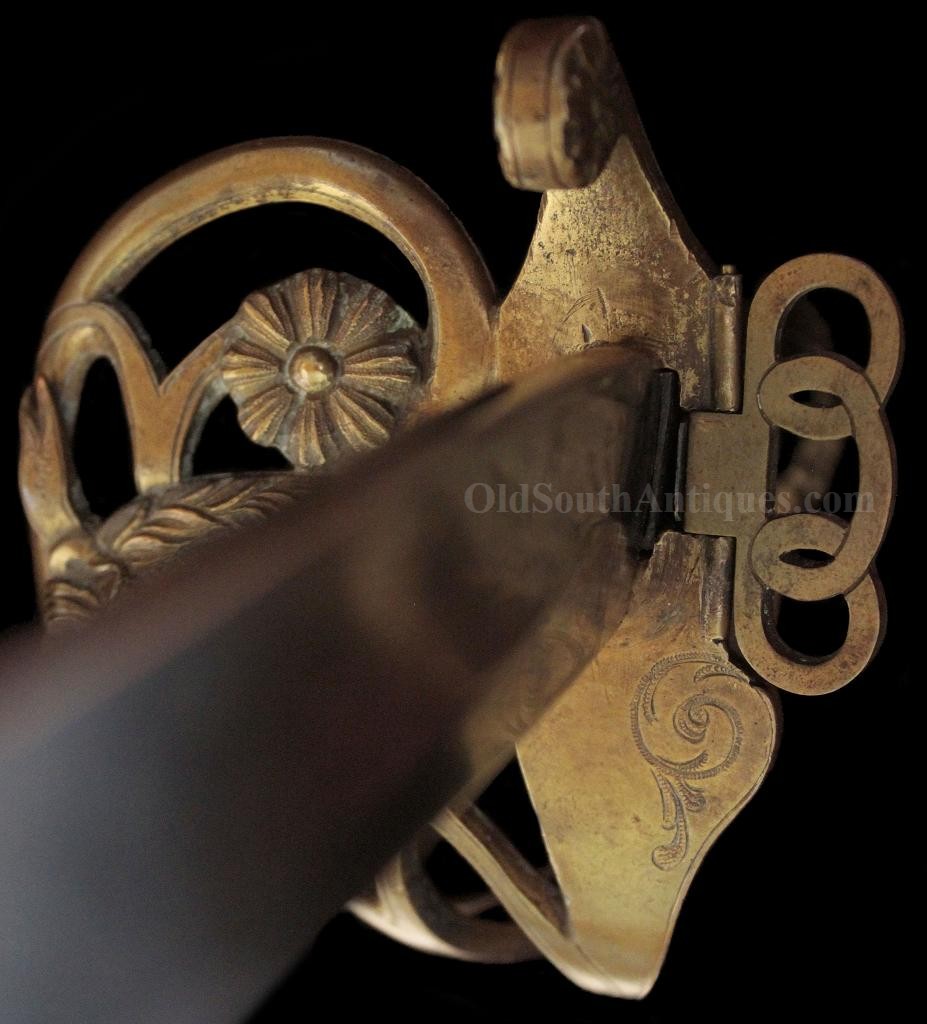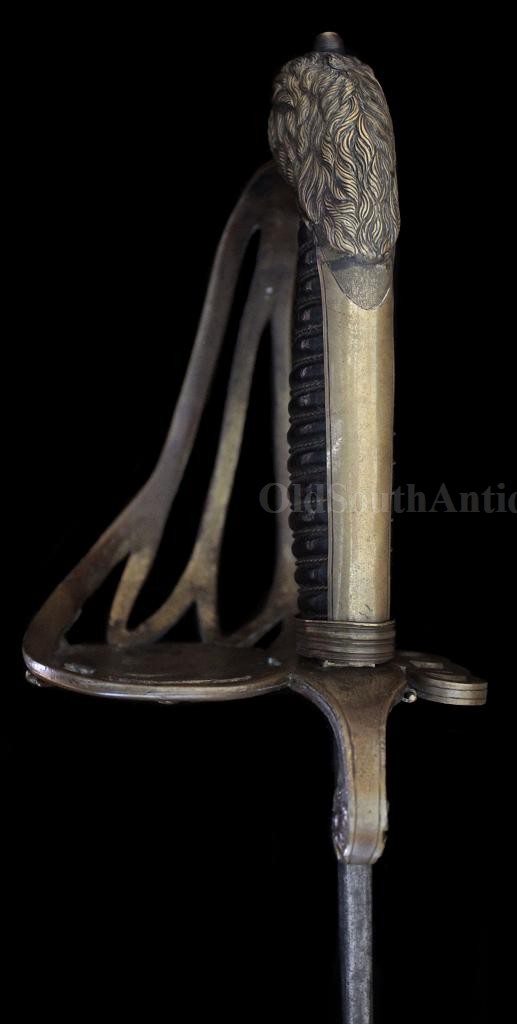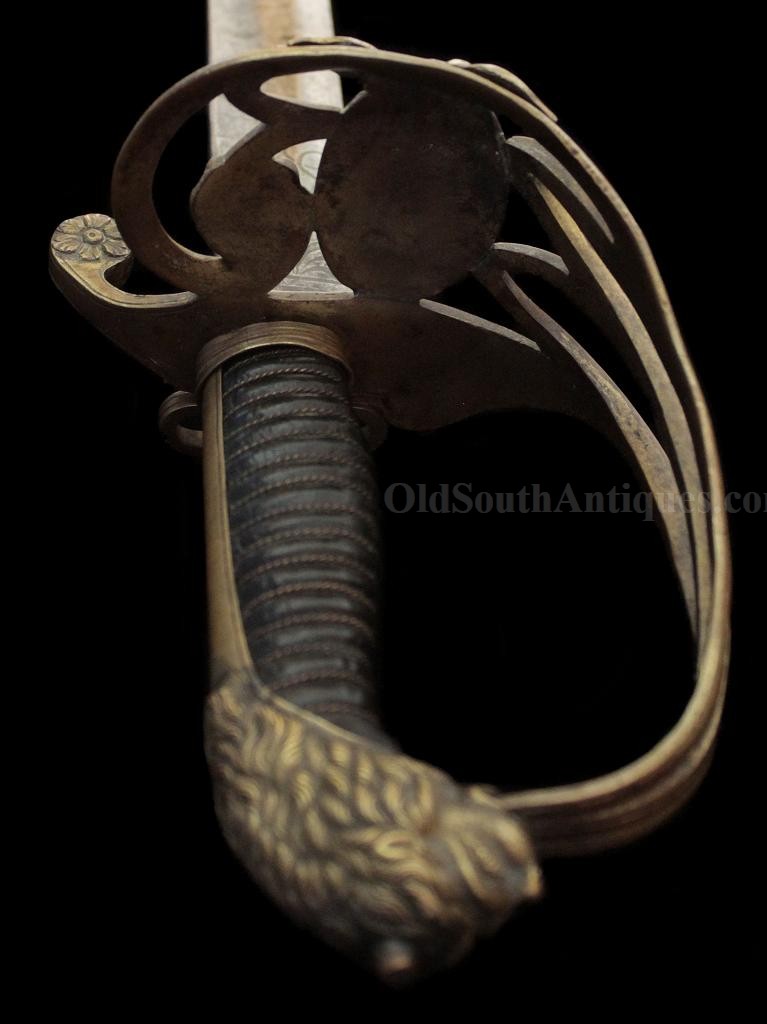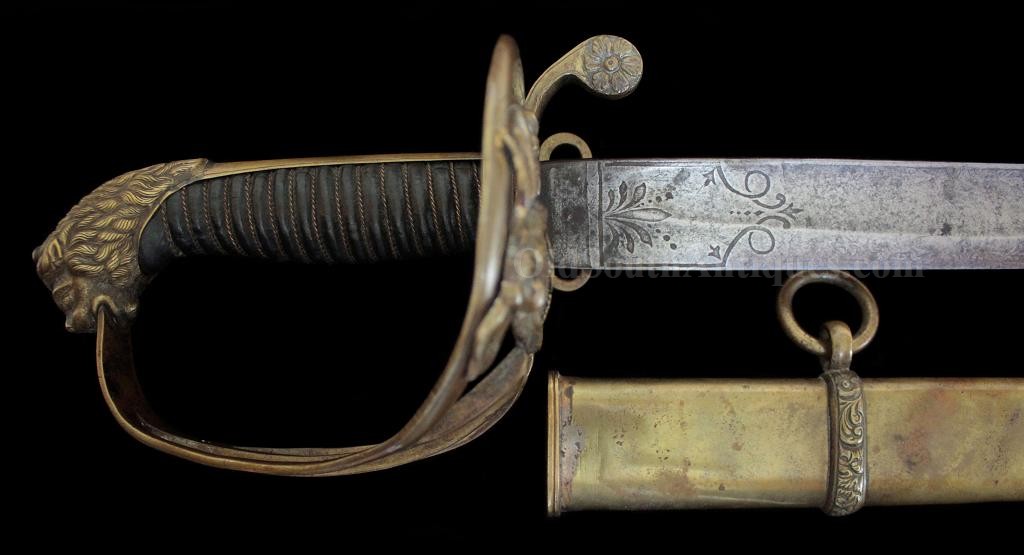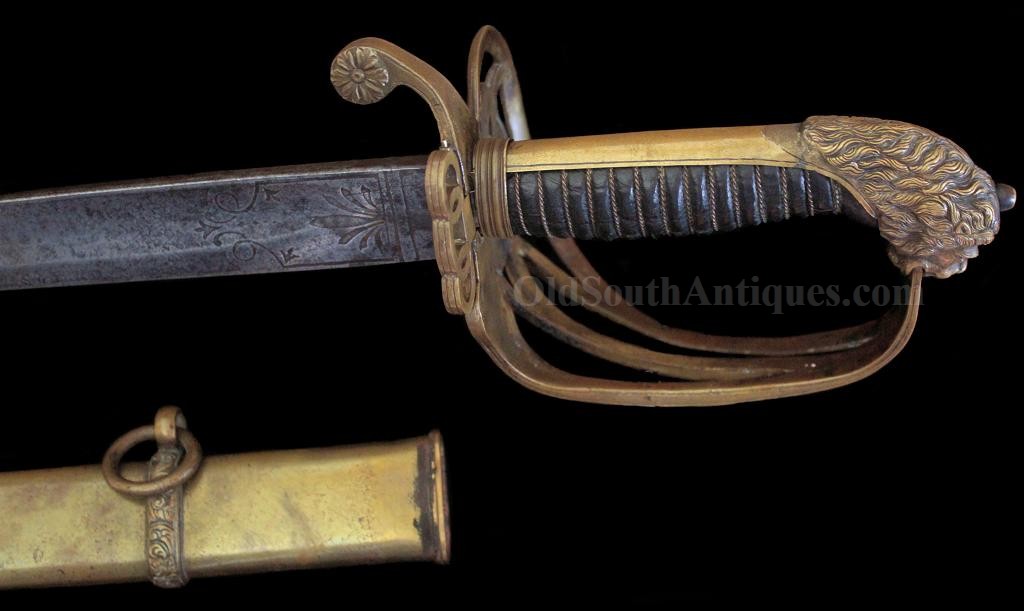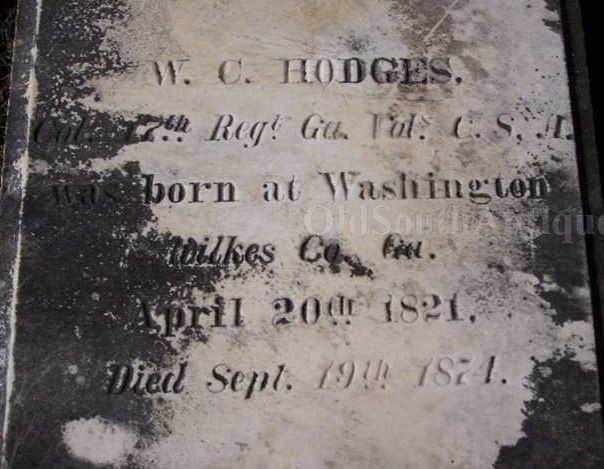
| Catalog | Past Items | Order Info | Terms/Conditions | About Us | Inventory Clearance |
Columbus, Georgia sword makers Louis and Elias Haiman operated the largest sword manufactory within the Southern Confederacy. They rented the top floor of a building at the corner of Thomas and Short streets, right beside the Haiman armory. Here they set up the Confederate States Sword Factory. They produced more cavalry swords for the Confederacy than all the other manufactures combined. They also made fine officer’s swords, though in very limited number. The officer’s swords were made not for the Confederacy, but for the retail trade to Confederate officers. They were etched by a local Columbus jeweler by the name of Spear, or a man named Kinsel. The Haiman brothers sold their officer’s sword at a street level showroom on Broad Street. These swords were made with an etched panel, which could be personalized at the purchaser’s request. This example has the panel, but it was never filled in. The company advertised "at reasonable prices for officers and sergeants, finished in the best quality for sale at the Confederate states Sword factory of Columbus, GA. We can furnish officers swords with belts for $25 or $22 if four were ordered in one lot. Our swords are tested according the rules laid down by the Manual of War.” The company also produced brass belt plates and cartridge boxes, leather bayonet mountings, camp stove parts, shotgun bayonets, rifle bayonets, wagon covers, revolvers (they had a contract for 10,000, but very few were produced), mess plates and tin cups.
The exquisite field and staff officer’s sword shown here is some of the very best of Haiman’s work. As best that I can tell, four of this beautiful pattern survive; one that belonged to Confederate General Alpheus Baker, another that belonged to General Archibald Gracie, and a third that belonged to General H.D. Clayton. This is the only one known that belonged to anyone other than a Confederate General; it belonged to Colonel Wesley C. Hodges, 17th Georgia Infantry.
It is identified by the etched panels on the blade. Within a scalloped box on the blade’s obverse is etched "L. Haiman and Brother Manufrs. Columbus Ga” and on the reverse side, "Col W C Hodges from F.W. Dillard & Richard Patton.” The name panel etchings are very weak due to someone trying to clean them long ago to make them more legible. They should have left them alone. Fortunately, under good light and with proper magnification the panels can be read.
I have tried to find the occasion of the presentation by Dillard and Patton, but so far have been unsuccessful. Captain Francis W. "Frank” Dillard was, like Hodges, a Columbus merchant prior to the War. Dillard raised a company known as the Georgia Grays, and later served as Assistant Quartermaster. He and Hodges were antebellum friends and business associates. I have been unable to identify Richard Patton.
The man who was presented and carried this sword in battle was Wesley Hodges. Wesley C. Hodges was born on April 20, 1821, in Washington, Georgia. Wesley graduated from Emory College in Oxford, Georgia in 1843. Returning from the Mexican War after a stint as a sergeant in the Georgia Volunteers he went into the family business, and in 1860, Wesley and his family were wealthy Columbus, Georgia merchants operating as Manly & Hodges.
Wesley Hodges enlisted in the Confederate Army on April 16, 1861 as a private in Company G, 2nd Georgia Infantry and on September 1, 1861, he was promoted to the Lieutenant Colonelcy of the 17th Georgia Infantry, which had just been organized and was led by future general Henry Benning. The 17th traveled to Virginia and was placed in Toombs Georgia Brigade, where it fought in the battles of Malvern Hill and 2nd Manassas, where 50 percent of the men were killed or wounded. The 17th fought on the right, above "Burnsides” bridge at Sharpsburg, but without Colonel Hodges. Though his official records do not mention a wound previous to Sharpsburg, his brigade commander at Sharpsburg, Brigadier General Robert Toombs, wrote in his official report: Colonel Benning being in command of the brigade, and Lieutenant-Colonel [Wesley C.] Hodges and Major [J. H.] Pickett both being absent, from severe wounds received by them in former battles, Captain McGregor led the Seventeenth Regiment with ability, courage, and skill.
The next fight came at the resounding victory at Fredericksburg. Shortly after that fight, on January 4, 1863, Hodges was promoted to the Colonelcy of the 17th after Benning was promoted to Brigadier General. Colonel Hodges led the 17th Georgia to Suffolk, Virginia in the spring of 1863, under James Longstreet to secure supplies for the Army. Returning to the Army of Northern Virginia after Chancellorsville, Colonel Hodges marched his men into Gettysburg, Pennsylvania, and there fought at the Devil’s Den under Hood and lost twenty-nine percent of their regiment. Colonel Hodge’s account of the battle as follows is found in the Official Records:
CULPEPER COURT-HOUSE VA., July 27, 1863.
SIR: Arriving with my command near the battle-field of Wednesday, July 1 at 12 p. m., the men, after a fatiguing march through the mountain pass, by way of Cashtown, were permitted to rest upon their arms until 3 p. m., at which time the march was resumed. After one other temporary halt, my regiment, in its place in Benning's brigade, was pushed forward to our right to assume position in lines assigned it. Notwithstanding the excessive heat of the day, and the circuitous route to reach said position, officers and men bore up cheerfully under the circuitous route to reach said position, officers and men bore up cheerfully under the annoyances. This being preliminary to the fight of July 2, and the second of the series of engagements near Gettysburg, in which my regiment actively participated, I may be excused for a detailed statement of the events occurring rapidly in our front. The Second and Seventeenth Regiments formed the right wing of Benning's brigade, and, after being formed in line facing the enemy, under a murderous fire of artillery, ably served, and volleys of musketry, dashed forward gallantly and with impetuosity, until a four gun battery of the enemy, from which we had received no little annoyance, was passed by the left of my regiment, and many of the officers and men, both of said battery and its support, composed in part of a detachment of the Fourth Maine Infantry, were captured and sent to the rear by the men of my command. It is not intended in this statement to set up any exclusive claim to the capture of the battery, which having had its support stripped from it in the manner indicated, remained at the command of the brigade until removed under cover of night. The position of my regiment in relation to this battery proves its instrumentality in the valuable capture. The impetuosity of the charge of the Second Regiment and my own, and the nature of the ground, threw us beyond the first crest, from which we had driven the enemy, into a deep gorge separating the seized crest from the stronger one, upon which the enemy now displayed a heavy force; and, but partially sheltered by scattering rocks, under a plunging fire from above it, my command bravely held its position, and seven times broke columns of the enemy which were forming for a vigorous onset to dislodge us. If affords me the utmost pleasure in testifying to the general good conduct and gallantry of the officers and men of the command. Never did men behave with more heroism. It is difficult to individualize. It is my opinion that not a man of the regiment could have been driven from this position, which was quietly held during the night. It should be remarked that the position taken and held by the Second and Seventeenth until the morning succeeding the fight was so considerably in advance of our lines, that under headquarters orders these commands were retired from it, for the purpose of completing our lines. I have had the honor previously of submitting a list of casualties. *
Very respectfully, yours, & amp;c.,
W. C. HODGES,
Colonel Commanding Seventeenth Georgia Volunteers.
In September of 1863, after a long train ride with General Longstreet, Benning’s Brigade pitched into the invaders at Chickamauga Creek, where the Confederates were victorious. Afterwards they served through the trials and tribulations of the cold East Tennessee Campaign before being shipped back to Virginia in time to fight in the Wilderness along the Orange Plank Road.
Colonel Hodges was shot through the right shoulder on May 6, 1864 in the fiery Battle of the Wilderness and was furloughed by the medical board for 60 days on the 15th instant. In July he went again before the board still suffering from his wound and was granted a thirty-day extension to his medical furlough. He never recovered enough to return to command. After the War he returned to his home in Columbus, Georgia. By 1870 he had restored at least eleven thousand dollars of his fortune as a successful cotton broker. He died on September 19, 1874, at the age of 53, and was buried in Columbus, Georgia.
Colonel Hodges’ sword was published in the 1988 edition of Confederate Presentation & Inscribed Swords and Revolvers by Dan Hartzler. In that work Mr. Hartzler writes, "The backstrap, capstan on the pommel and the reverse counterguard of this lovely officer’s sword has been repaired.”
I had examined the sword carefully when I acquired it and had not found any repairs, so I reexamined it using a 750x microscope. Still I found no repairs, though I could see some discoloration that a man casually examining it could mistake for a repair. But, in deference to Mr. Hartzler’s opinion, I contacted the collector who had owned the sword in the 1980s when Mr. Hartzler examined the sword, to find out what he knew about Mr. Hartzler’s claim. He stated that the sword had never been repaired and that at the time it was examined by Mr. Hartzler, he had made no indication of having found a repair. In fact, he was taken aback to learn that such a thing had been written.
Please do not misunderstand my statements; I love my copy of Confederate Presentation & Inscribed Swords and Revolvers, and I highly recommend it to all. I recognize that there are errors in all man-made works (including my own books). It is impossible to create a book of the size of Mr. Hartzler’s without making some mistakes, and we in fact owe him a great debt for his good work in compiling this wonderful book full of historical treasures. I merely wish to correct the history of this sword for future collectors.
The beautifully etched sword and its scabbard are in excellent condition. The etched lines, stars, Georgia State Seal, CS wrapped in laurel and the panoply of arms are etched so deeply that they can be clearly seen across the room. These were apparently done during the manufacturing process; the presentation panels were done after that and were etched only lightly, so that the presentation panels are very weakly etched and have to be deciphered, rather than read. If the grip was originally covered with leather rather than having polished wood, the leather is completely gone with no trace, leaving a very attractive dark grip. The sword is sheathed in it original, ornate all brass scabbard, which is in virtually perfect condition.
A Haiman sword of this ornate pattern was presented to General Alpheus Baker; another was presented to General H. D. Clayton, and a third to General Archibald Gracie; Colonel Hodges was in very good company. These four are to my knowledge the only known existing examples of this Confederate work of art and war.
This sword will without doubt be featured in Shannon Pritchard’s upcoming, full color "Confederate Swords of the Old South” and will likely be featured on the front cover because of its unique beauty.
Copyright © 2025 OldSouthAntiques.com All Rights Reserved.
Privacy Policy | Terms of Use
Powered by Web-Cat Copyright © 1996-2025 GrayCat Systems
